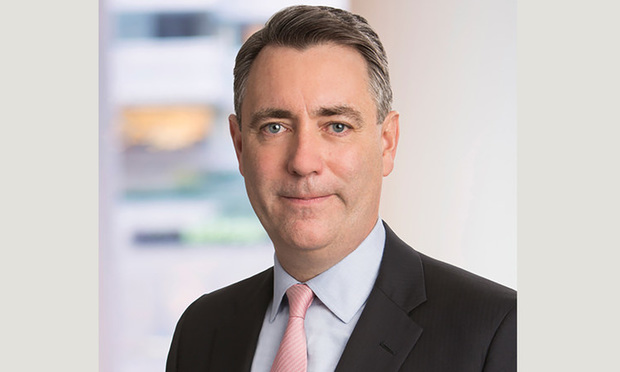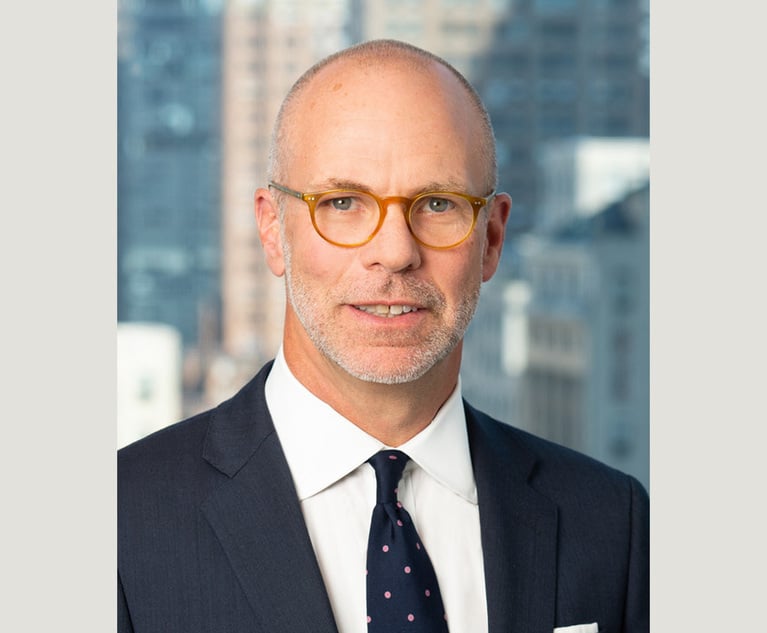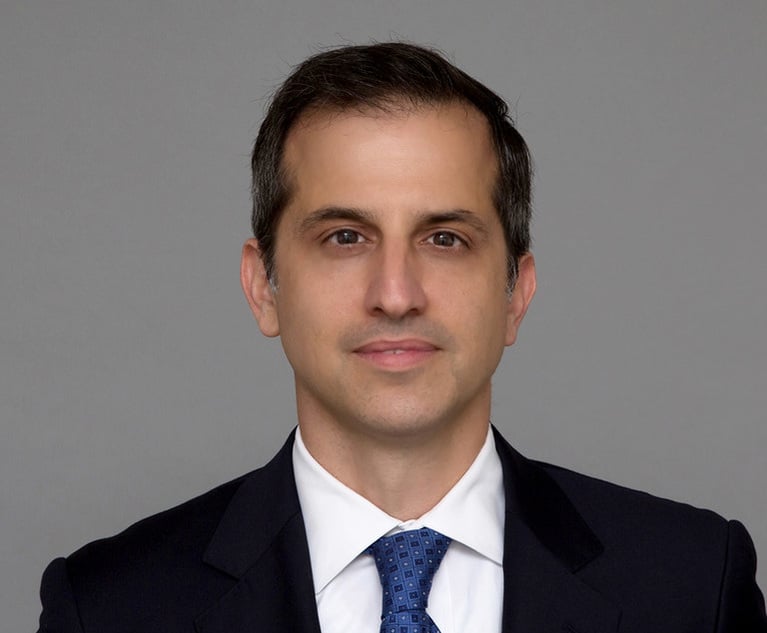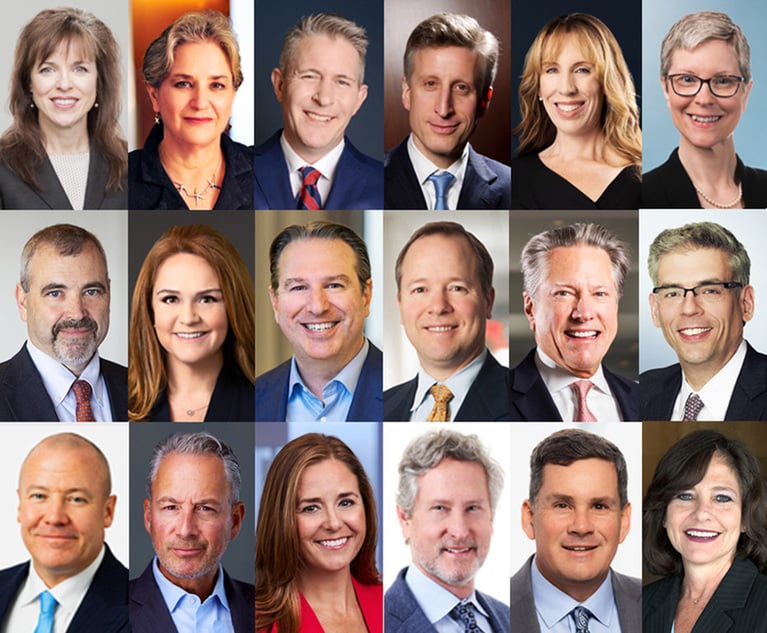Litigation Leaders: Hogan Lovells' Des Hogan on Depth, Diversity and the (Little League) World Series
'When we are defending, we commit to finding the best path, even if it is not the standard path, to extinguish cases early so our clients can avoid the expense and distraction of time-consuming litigation.'
October 28, 2019 at 08:38 PM
10 minute read
 Des Hogan of Hogan Lovells.
Des Hogan of Hogan Lovells.
Welcome another edition of our Litigation Leaders series. Meet Des Hogan, who took over earlier this year as the Head of Litigation for the Americas for Hogan Lovells.
Based in Washington, D.C., he continues to practice full-time as a class action lawyer who focuses on MDLs and other large cases in the life sciences, cyber security, technology, and food spaces. Hogan also has a separate expertise in representing companies and executives who are called to testify by congressional committees.
Lit Daily: Tell us a little about yourself—beyond what's in your law firm bio.
Des Hogan: I am passionate about youth sports because they are a mixture of pure joy, a few tears, and innumerable life lessons about resilience. Some of my best moments have been coaching my daughter and son on the basketball court, baseball field, and soccer pitch.
And, in the thrill of my son's life (and mine too), our team won the D.C. Little League championship and we ended up playing several games in the Little League World Series Tournament that was televised on ESPN. Back here at the firm, it was broadcasted on TVs where my colleagues watched in a conference room and cheered along for my crew of kids.
How big is your litigation department and where are most of your litigators concentrated geographically?
Worldwide we have approximately 800 lawyers in our practice. Focusing solely on the United States, we have more than 350 attorneys and about 75 other professionals who support the practice. We have significant litigation presence in all 14 of our offices, but by pure numbers the offices with the largest contingent are D.C., New York, Boston, Miami, and L.A.
In what three areas of litigation do you have the deepest bench? (I know it's tempting to list more, but please just name three.)
Has anybody ever started the answer to this question without saying "It is impossible to limit this to just three"? Because that pat answer reflects exactly how I feel.
But in respect to your premise, I give a nod to: (1) our class action bench that, for the two-plus decades I have been at the firm, has been involved in the biggest consumer, life sciences, automotive, products, and antitrust class actions in the country; (2) our unparalleled appellate group that argues multiple cases every year in every circuit, many state high courts, and the U.S. Supreme Court; and (3) our privacy and cybersecurity litigation team, which we have built from scratch over the course of the past decade, and handles the most high-profile data breach and privacy-related matters for house-hold name clients every day.
As head of the department, what are some of your goals or priorities?
Three immediately come to mind. First, we want the entire market to recognize what our clients already know: We are a powerhouse litigation practice that is fiercely effective in both the courtroom and boardroom at protecting our clients' interest. We do this by charting winning litigation strategies with specialized knowledge of the regulatory landscape and industry sectors in which our clients must operate.
Second, we want to continue our long history of being a leader in diversity, putting concrete steps in place to ensure that our litigation teams reflect the diversity of the country.
Third, we want to continue to bring our practice—which spans Boston to LA, Miami to San Francisco and many spots in between—closer together so that the lawyers with the best expertise are handling our clients' most important matters, regardless of their home office.
What do you see as hallmarks of your firm's litigators? What makes you different?
Our litigation team is comprised of extraordinarily talented lawyers who can handle complex cases that pose existential threats to our clients' business plans. What sets us apart is our willingness to go the distance, and try a case to verdict, if that's in our client's best interest. We of course make reasonable judgements about when to fight, and when not to. But we are not afraid to go for the win in court, vigorously, and we succeed regularly. Not every law firm out there has the in-court track record that we do.
Another reason we are so effective is our comprehensive understanding of our clients' business—and the issues that keep them up at night. That comes from having litigators who have significant industry sector expertise and have spent decades in the trenches with clients. But it also comes from our consistent practice of partnering with our regulatory lawyers to get the best outcomes for our clients. In this way, we are able to provide litigation strategy that helps our clients win the case and positions them best to continue to ski between the gates of the governmental rules and agency scrutiny.
This approach helps us keep our eye on what is important: Winning the matter at hand, but doing so in a manner that recognizes the risks, business environment, and competitive pressures our clients face in the market and the need to keep maintain continuity of operations and profitability.
How many lateral litigation partners have you hired in the last 12 months? What do you look for in lateral hires?
In the past year, we added two partners to our practice in the States via lateral recruiting, Chris Cox in Silicon Valley and Ann Kim in Los Angeles, both of whom have substantially strengthened the depth of our offerings in California.
This is coming off a two-year period in which we had added significant pieces in Boston and New York and we have been focused on the hard and exhilarating work of integrating all of those lawyers into our larger practice.
But today, as we assess a market that presents significant recruiting opportunities for us, we are looking for the obvious: groups of partners who have large, sticky client relationships; and the intangible: people who are willing to do the work of getting to know our partners and clients, which means getting on planes, going to other offices, visiting our clients, and multiplying their practices using the incredible network of client relationships that exist in our litigation, regulatory and corporate groups.
What were some of your firm's biggest in-court wins in the past year?
There are quite a few from which to choose, but here are a few:
We won a jury verdict on all claims in a nearly $400 million jury trial for Orbital ATK, defeating claims for breach of contract and tortious interference brought by U.S. Space LLC over the dissolution of a joint venture created by Orbital ATK and U.S. Space to market Orbital ATK's new spacecraft, the MEV.
We secured a major Supreme Court victory for Epic Systems and Murphy Oil Company in a landmark case preserving the right of employers to enter into individualized arbitration agreements with their employees. In the case, the court decisively rejected the assertion that class action waivers are forbidden by the National Labor Relations Act.
After seven years of hard-fought litigation–including numerous fact and expert depositions in the U.S. and Korea–we have achieved massive victories for Hyundai in securing the denial of class action certification in two cases related to alleged brake defects, and also established a precedent that is crucial to counterbalance several recent decisions that have answered similar issues in favor of the plaintiffs.
Following an extensive trial, as well as preliminary injunction proceedings, we won a permanent injunction preventing the U.S. Department of Justice from withholding formula grant funding from the City of Philadelphia because of the city's efforts to protect immigrants through so-called "Sanctuary City" policies.
Can you give an example or two of tactics that exemplify your firm's approach to litigating cases?
When we are defending, we commit to finding the best path, even if it is not the standard path, to extinguish cases early so our clients can avoid the expense and distraction of time-consuming litigation.
Case in point, recently for a major technology company we opposed the normal course of most MDLs, which has plaintiffs filing a consolidated amended complaint that lumps together claims of dozens of lawsuits. We opposed this well-worn path because we knew that the threshold flaws in the underlying class actions would be best exposed if defendants had the space in individual briefs to detail plaintiffs' lack of standing, the application of arbitration provisions, and other legal flaws in the cases.
It paid off. The court denied leave to allow the filing of a consolidated amended complaint and ordered "bellwether" filings of motions to dismiss and to compel arbitration. And in every one of those many bellwethers we have briefed, the court has ruled for our client, granting our threshold, dispositive motions before any discovery commenced.
Where are you looking to build or expand in the next year?
Since entering my new role earlier this year, we have been looking hard at changing the old model that most firms have followed, ours included, which is to fill gaps. Instead, we are now focused on building further on our strengths.
So, for example, we will look to further build out practices—both through advancement and recruitment—that historically have been our most successful and we would like to add to our depth in major markets such as D.C., New York, and California. We have deep client relationships, a focused leadership team, and wonderful culture that makes us an attractive destination.
See our prior Litigation Leaders profiles:
Sullivan & Cromwell's Sharon Nelles on Big Personalities, Mutual Respect and Associate Development
Covington's John Hall on Plaintiffs-Side Work, Partner Promotions and the 'Plus Factor'
Quinn Emanuel's Diane Doolittle on Show Jumping, Street Smarts and Bet-the-Company Cases
Cleary's David Brodsky on Lockstep Compensation, Latin America and Lateral Hires
Skadden's David Zornow on Top Talent, 'Walking Through Walls for Clients' and Joe Flom's Legacy
Wilmer's Howard Shapiro on 'Classic Trial Lawyering,' Suing the Government and Lateral All-Stars
Morgan Lewis' Gordon Cooney on Crisis Management, Data Analytics and the Importance of Teamwork
Kirkland's Mark Filip on Lateral Hiring, 'Perry Mason' Moments and Training the Next Generation
Cooley's Mike Attanasio on Strategy, Lateral Hires and Training New Trial Lawyers
This content has been archived. It is available through our partners, LexisNexis® and Bloomberg Law.
To view this content, please continue to their sites.
Not a Lexis Subscriber?
Subscribe Now
Not a Bloomberg Law Subscriber?
Subscribe Now
NOT FOR REPRINT
© 2025 ALM Global, LLC, All Rights Reserved. Request academic re-use from www.copyright.com. All other uses, submit a request to [email protected]. For more information visit Asset & Logo Licensing.
You Might Like
View All
2024 Marked Growth On Top of Growth for Law Firm Litigation Practices. Is a Cooldown in the Offing for 2025?

Big Company Insiders See Technology-Related Disputes Teed Up for 2025

Litigation Leaders: Jason Leckerman of Ballard Spahr on Growing the Department by a Third Via Merger with Lane Powell
Trending Stories
Who Got The Work
J. Brugh Lower of Gibbons has entered an appearance for industrial equipment supplier Devco Corporation in a pending trademark infringement lawsuit. The suit, accusing the defendant of selling knock-off Graco products, was filed Dec. 18 in New Jersey District Court by Rivkin Radler on behalf of Graco Inc. and Graco Minnesota. The case, assigned to U.S. District Judge Zahid N. Quraishi, is 3:24-cv-11294, Graco Inc. et al v. Devco Corporation.
Who Got The Work
Rebecca Maller-Stein and Kent A. Yalowitz of Arnold & Porter Kaye Scholer have entered their appearances for Hanaco Venture Capital and its executives, Lior Prosor and David Frankel, in a pending securities lawsuit. The action, filed on Dec. 24 in New York Southern District Court by Zell, Aron & Co. on behalf of Goldeneye Advisors, accuses the defendants of negligently and fraudulently managing the plaintiff's $1 million investment. The case, assigned to U.S. District Judge Vernon S. Broderick, is 1:24-cv-09918, Goldeneye Advisors, LLC v. Hanaco Venture Capital, Ltd. et al.
Who Got The Work
Attorneys from A&O Shearman has stepped in as defense counsel for Toronto-Dominion Bank and other defendants in a pending securities class action. The suit, filed Dec. 11 in New York Southern District Court by Bleichmar Fonti & Auld, accuses the defendants of concealing the bank's 'pervasive' deficiencies in regards to its compliance with the Bank Secrecy Act and the quality of its anti-money laundering controls. The case, assigned to U.S. District Judge Arun Subramanian, is 1:24-cv-09445, Gonzalez v. The Toronto-Dominion Bank et al.
Who Got The Work
Crown Castle International, a Pennsylvania company providing shared communications infrastructure, has turned to Luke D. Wolf of Gordon Rees Scully Mansukhani to fend off a pending breach-of-contract lawsuit. The court action, filed Nov. 25 in Michigan Eastern District Court by Hooper Hathaway PC on behalf of The Town Residences LLC, accuses Crown Castle of failing to transfer approximately $30,000 in utility payments from T-Mobile in breach of a roof-top lease and assignment agreement. The case, assigned to U.S. District Judge Susan K. Declercq, is 2:24-cv-13131, The Town Residences LLC v. T-Mobile US, Inc. et al.
Who Got The Work
Wilfred P. Coronato and Daniel M. Schwartz of McCarter & English have stepped in as defense counsel to Electrolux Home Products Inc. in a pending product liability lawsuit. The court action, filed Nov. 26 in New York Eastern District Court by Poulos Lopiccolo PC and Nagel Rice LLP on behalf of David Stern, alleges that the defendant's refrigerators’ drawers and shelving repeatedly break and fall apart within months after purchase. The case, assigned to U.S. District Judge Joan M. Azrack, is 2:24-cv-08204, Stern v. Electrolux Home Products, Inc.
Featured Firms
Law Offices of Gary Martin Hays & Associates, P.C.
(470) 294-1674
Law Offices of Mark E. Salomone
(857) 444-6468
Smith & Hassler
(713) 739-1250







